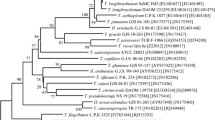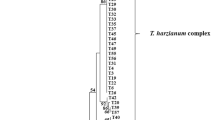Abstract
Pyrene, a toxic four-benzene-ring that persists in the ecosystem, is highly resistant to degradation. The goal of the research is to screen, isolate, and identify pyrene-degrading filamentous fungi via the molecular biological identification method. The capabilities of identified isolates in biodegradation and transformation of pyrene were also evaluated. Based on the morphological characterization and sequence alignments, results of neighbor-joining phylogenetic tree from 18S rRNA of F03 revealed that genetic similarity had achieved 99% of homology percentage and identified as Trichoderma sp. Trichoderma sp. F03 was able to degrade pyrene (78%) when culture conditions were set at 100 mg/L initial pyrene concentration in culture medium with pH 5 at 27 °C, the use of glucose as a carbon source and polyethylene glycol sorbitan monooleate as a biosurfactant without agitation. Finally, three metabolites, benzoic acid, 3-hydroxybenzoic acid, and acetic acid, were detected during the pyrene degradation process by using gas chromatography–mass spectrometry (GCMS).






Similar content being viewed by others
References
Adnan, L. A., Sathishkumar, P., Mohd Yusoff, A. R., & Hadibarata, T. (2015). Metabolites characterisation of laccase mediated Reactive Black 5 biodegradation by fast growing ascomycete fungus Trichoderma atroviride F03. International Biodeterioration & Biodegradation, 104, 274–282.
Alexander, J. T., Hai, F. I., & Al-aboud, T. M. (2012). Chemical coagulation-based processes for trace organic contaminant removal: current state and future potential. Journal of Environmental Management, 111, 195–207.
Dai, Y., Zhang, N., Xing, C., Cui, Q., & Sun, Q. (2019). The adsorption, regeneration and engineering applications of biochar for removal organic pollutants: a review. Chemosphere, 223, 12–27.
Hadibarata, T., Khudhair, A. B., Kristanti, R. A., & Kamyab, H. (2017). Biodegradation of pyrene by Candida sp. S1 under high salinity conditions. Bioprocess and Biosystems Engineering, 40, 1411–1418.
Hadibarata, T., & Kristanti, R. A. (2014). Fluorene biodegradation and identification of transformation products by white-rot fungus Armillaria sp. F022. Biodegradation, 25, 373–382.
Jia, C., Li, P., Li, X., Tai, P., Liu, W., & Gong, Z. (2011). Degradation of pyrene in soils by extracellular polymeric substances (EPS) extracted from liquid cultures. Process Biochemistry, 46, 1627–1631.
Kamyabi, A., Nouri, H., & Moghimi, H. (2018). Characterization of pyrene degradation and metabolite identification by Basidioascus persicus and mineralization enhancement with bacterial-yeast co-culture. Ecotoxicology and Environmental Safety, 163, 471–477.
Kong, L., Gao, Y., Zhou, Q., Zhao, X., & Sun, Z. (2018). Biochar accelerates PAHs biodegradation in petroleum-polluted soil by biostimulation strategy. Journal of Hazardous Materials, 343, 276–284.
Kristanti, R. A., Hadibarata, T., Toyama, T., Tanaka, Y., & Mori, K. (2011). Bioremediation of crude oil by white rot fungi Polyporus sp. S133. Journal of Microbiology and Biotechnology, 21, 995–1000.
Kudlek, E., & Dudziak, M. (2018). Degradation pathways of pentachlorophenol and benzo(a)pyrene during heterogeneous photocatalysis. Water Science and Technology, 77, 2407–2414.
Lamichhane, S., Bal Krishna, K. C., & Sarukkalige, R. (2017). Surfactant-enhanced remediation of polycyclic aromatic hydrocarbons: A review. Journal of Environmental Management, 199, 46–61.
Lazim, Z. M., & Hadibarata, T. (2016). Ligninolytic fungus Polyporus sp. S133 mediated metabolic degradation of fluorene. Brazilian Journal of Microbiology, 47, 610–616.
Liang, Y., Gardner, D. R., Miller, C. D., Chen, D., Anderson, A. J., Weimer, B. C., Sims, R. C., (2006). Study of biochemical pathways and enzymes involved in pyrene degradation by Mycobacterium sp. strain KMS. Applied and Environmental Microbiology, 72(12), 7821–7828.
Majcherczyk, A., Johannes, C., & Hüttermann, A. (1998). Oxidation of polycyclic aromatic hydrocarbons (PAH) by Laccase of Trametes versicolor. Enzyme and Microbial Technology, 22, 335–341.
Miao, Y., Li, P., Li, G., Liu, D., Druzhinina, I. S., Kubicek, C. P., Shen, Q., & Zhang, R. (2017). Two degradation strategies for overcoming the recalcitrance of natural lignocellulosic xylan by polysaccharides-binding GH10 and GH11 xylanases of filamentous fungi. Environmental Microbiology, 19, 1054–1064.
Monteiro, A. F., Seidl, C., Severino, V. G. P., Cardoso, C. L., & Castro-Gamboa, I. (2017). Biotransformation of labdane and halimane diterpenoids by two filamentous fungi strains. Royal Society Open Science, 4, 170854.
Ncube, S., Kunene, P., Tavengwa, N. T., Tutu, H., Richards, H., Cukrowska, E., & Chimuka, L. (2017). Synthesis and characterization of a molecularly imprinted polymer for the isolation of the 16 US-EPA priority polycyclic aromatic hydrocarbons (PAHs) in solution. Journal of Environmental Management, 199, 192–200.
Peng, X., Yuan, X. Z., Liu, H., Zeng, G. M., & Chen, X. H. (2015). Degradation of polycyclic aromatic hydrocarbons (PAHs) by laccase in rhamnolipid reversed micellar system. Applied Biochemistry and Biotechnology, 176, 45–55.
Rabodonirina, S., Rasolomampianina, R., Krier, F., Drider, D., Merhaby, D., Net, S., & Ouddane, B. (2019). Degradation of fluorene and phenanthrene in PAHs-contaminated soil using Pseudomonas and Bacillus strains isolated from oil spill sites. Journal of Environmental Management, 232, 1–7.
Santos, L. O., dos Anjos, J. P., Ferreira, S. L. C., & de Andrade, J. B. (2017). Simultaneous determination of PAHS, nitro-PAHS and quinones in surface and groundwater samples using SDME/GC-MS. Microchemical Journal, 133, 431–440.
Song, H.-G. (1999). Comparison of pyrene biodegradation by white rot fungi. World Journal of Microbiology and Biotechnology, 15, 669–672.
Vaidya, S., Devpura, N., Jain, K., & Madamwar, D. (2018). Degradation of chrysene by enriched bacterial consortium. Frontiers in Microbiology, 9, 1333.
Wang, S., Li, X., Liu, W., Li, P., Kong, L., Ren, W., Wu, H., & Tu, Y. (2012). Degradation of pyrene by immobilized microorganisms in saline-alkaline soil. Journal of Environmental Sciences, 24, 1662–1669.
Wirasnita, R., & Hadibarata, T. (2016). Potential of the white-rot fungus Pleurotus pulmonarius F043 for degradation and transformation of Fluoranthene. Pedosphere, 26, 49–54.
Zhang, H., Zhang, S., He, F., Qin, X., Zhang, X., & Yang, Y. (2016). Characterization of a manganese peroxidase from white-rot fungus Trametes sp.48424 with strong ability of degrading different types of dyes and polycyclic aromatic hydrocarbons. Journal of Hazardous Materials, 320, 265–277.
Zheng, G., Selvam, A., & Wong, J. W. C. (2012). Oil-in-water microemulsions enhance the biodegradation of DDT by Phanerochaete chrysosporium. Bioresource Technology, 126, 397–403.
Zhu, F., Storey, S., Ashaari, M. M., Clipson, N., & Doyle, E. (2017). Benzo(a)pyrene degradation and microbial community responses in composted soil. Environmental Science and Pollution Research, 24, 5404–5414.
Funding
The authors would like to thank the Deanship of Scientific Research at King Saud University, Saudi Arabia, for funding this work through research group no. RG1439-044 and AUN/Seed-Net JICA grant under the contract no. 4B231.
Author information
Authors and Affiliations
Corresponding author
Additional information
Publisher’s Note
Springer Nature remains neutral with regard to jurisdictional claims in published maps and institutional affiliations.
Rights and permissions
About this article
Cite this article
Al Farraj, D.A., Hadibarata, T., Elshikh, M.S. et al. Biotransformation and Degradation Pathway of Pyrene by Filamentous Soil Fungus Trichoderma sp. F03. Water Air Soil Pollut 231, 168 (2020). https://doi.org/10.1007/s11270-020-04514-0
Received:
Accepted:
Published:
DOI: https://doi.org/10.1007/s11270-020-04514-0




